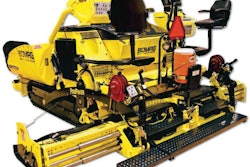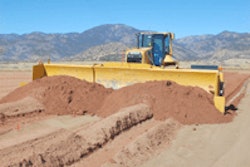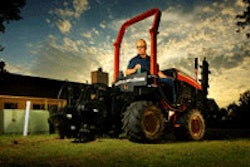 It’s no secret the best defense against weeds is maintaining a dense, healthy stand of grass. But sometimes even the most carefully developed and regimented maintenance programs aren’t enough. Weeds are going to invade. They are opportunistic pests.
It’s no secret the best defense against weeds is maintaining a dense, healthy stand of grass. But sometimes even the most carefully developed and regimented maintenance programs aren’t enough. Weeds are going to invade. They are opportunistic pests.
By Cindy Ratcliff
It’s best to treat most broadleaf weeds in the spring or fall when temperatures are mild (between 65 degrees Fahrenheit and 85 degrees Fahrenheit) and when weeds are actively growing. During hotter weather, you risk damaging turf. You also may have to make more than one application. To get the control you want, it’s sometimes necessary to repeat applications up to three times in seven- to 10-day intervals.
Remember to consider the weather when timing application of post-emergence herbicides. You’ll want to treat weeds when no rain is expected for at least 24 hours following a liquid application. (Of course, if you’re using a granular formulation this doesn’t apply, as most of them should be watered-in.) And you shouldn’t ever try to spray chemical treatments on windy days.
If you’ve just seeded an area, do not treat with herbicides until the turf is well-established. Until you’ve mowed it at least three times, turf is not secure enough to accept the herbicide application. Even then, you should use half the label-recommended rate. If you’re planning to overseed following a post-emergence herbicide application, you should wait one to four weeks to do so.
Once there is visible evidence that weeds have invaded, it’s time to select a post- emergence herbicide. Post-emergence herbicides are for weeds you can see (those that have already sprouted), as opposed to pre-emergence herbicides, which are used pro-actively to decrease the potential for future weeds. (So while it’s too late to use a pre-emergent once weeds are visible, you may want to explore this option in the future.)
Post-emergence herbicides can be divided into two categories: selective and non-selective. A selective herbicide will target weeds without damaging the surrounding desirable turf. A non-selective herbicide, such as Roundup or Finale, will kill plants indiscriminately. If only a few weeds are present, or if you’re treating weeds in an area not surrounded by other plants choose a non-selective herbicide. Otherwise, you’ll want to use a selective post-emergence herbicide.
Tame dandelions and crabgrass
 If you can control crabgrass for several consecutive season, it will eventually disappear.
If you can control crabgrass for several consecutive season, it will eventually disappear.
Post-emergence herbicides are used to treat a variety of broadleaf weeds, including dandelion. Of all the broadleaf weeds, dandelion is one of the most prevalent and, thus, most recognizable. It is a simple perennial weed. It left untreated, it will come back year after year.
To rid those eye-catching yellow flowers and puffballs, spot-treatment is often effective. Use a 2, 4-D or dicamba-based broadleaf herbicide in turf areas; this will not damage the underlying grass. In landscaping beds, 2, 4-D can be used but will damage surrounding shrubs and other ornamental plantings if accidentally sprayed, or if spray mist drifts to them.
Post-emergence herbicides can also tackle grassy weeds, such as crabgrass. Crabgrass is an annual weed, which means that it reappears every year only through the germination of new seed. So if you can control it for several consecutive seasons, it won’t have the opportunity to spread its seeds and it will eventually disappear. To do so, you can choose from a variety of products and formulations, including fenoxaprop, DSMA (disodium methyl arsonate), dithiopyr (effective only on crabgrass seedlings), MSMA (monosodium methyl arsonate) and quinclorac, which is the safest for turfgrass seedlings. Remember that all post-emergence herbicides yield the most effective results when used on small crabgrass plants.
 Spot-treatment with a dicamba-based broadleaf herbicide should get rid of dandelions.
Spot-treatment with a dicamba-based broadleaf herbicide should get rid of dandelions.
The most critical element for selecting a good post-emergence herbicide is that you must read and follow the label. Accurately identify weeds and be sure that the product you choose can be used on the type of grass you’re working with. Continue good cultural practices (proper mowing, fertilization and irrigation) to encourage rapid fill-in of the turf. Otherwise, new weeds will quickly reinfest the bare soil left open by the recently killed weeds. v
Cindy Ratcliff is chemical editor for Total Landscape Care magazine, a sister publication to Better Roads.
Contact her at [email protected].












